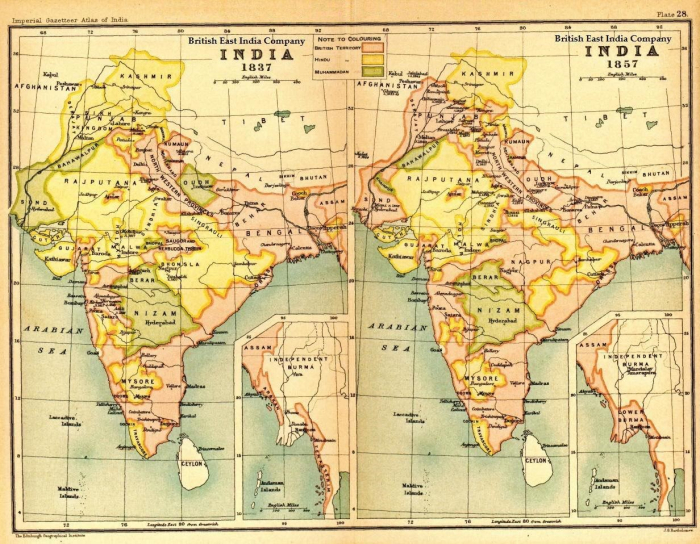

Britishers came to India in the 1600s as a trading company named, East India Company. Initially, the only agenda of EIC was to get raw materials at the cheapest price in India and sell them to other parts of the world and gain maximum benefit. After 1707 the last strong emperor of the Mughal empire Aurangzeb died and it allowed the EIC to cut off the taxes that they were paying to Indian kings. They saw it as an opportunity to maximize their income.
The first factory of Britishers was in Bengal and after the Battle of Plassey and Battle of Buxar, Britishers gain total control over the province. These two wars changed the policy of EIC, now they wanted to administer and control India which will be more profitable for them. Britishers appointer Residents in Indian states and started interfering in the internal matters also. They started the policy of subsidiary alliance in which, the partner state was not allowed to have its army instead the British army would be stationed there and all the expenses will be taken from the king of such state.
This policy made the Britishers the most powerful in India. The last policy of annexation adopted by EIC before gaining full control of India was the Doctrine of Lape. It was introduced by the Governor General, Lord Dalhousie in the year 1848.

Lord Dalhousie
George Richmond, Public domain, via Wikimedia Commons
The Doctrine of Lapse was the final nail in the coffin of Indian kingdoms. It was a policy introduced by Governor General, Lord Dalhousie in 1848. The Doctrine claimed that for those kings who had not their male hair when they deceased, the kingdom will automatically come under British rule.
Dalhousie aimed to end the Mughal empire completely and that is why he rejected the right to the adoption of hair, by the kings. He only gave the right to property to the king’s true-born son.
With this policy, EIC claimed major states of India and it acted as a great policy in the annexation of India. Some states which were annexed using this policy were, Satara, Udaipur, Sambalpur, Jhansi, Awadh and Nagpur.
The Britishers justified the Doctrine on the grounds of saving the people from misgovernment and misconduct from nawabs. Dalhousie claimed that the old system of rule by Sham rulers was creating misery for people.
Dalhousie wanted to remove the rulers who claimed to be the descents of Mughals and claimed their right to rule.

British Territory During 1857
Edinburgh Geographical Institute., Public domain, via Wikimedia Commons
Satara was an Indian kingdom which was formed in 1818, during the third Anglo-Maratha war.
It was annexed by the Britishers in the year 1848.
The ruler of Satara, Appa Sahib died in 1848, without leaving any son as successor and that was the reason lord Dalhousie annexed the state of Satara.
Sambalpur was Invaded and ruled by Marathas till 1817.
After the third Anglo- Maratha war, Britishers made a local king Raja Narayan sing the ruler of Sambalpur.
Raja Narayan Singh died in 1849 without any male hair and thus the kingdom was annexed by Britishers.
Udaipur was annexed in 1852.
Lord canning later toppled the annexation of Udaipur, because the board of directors declared it as a protected ally.
After The Third Anglo- Maratha war, The Maratha kingdom came under a subsidiary alliance with the Britishers.
Britishers recognised an Infant as the ruler of the state.
Till 1830, A British resident was present in court and transferred the power to the king in 1830.
The ruler died in 1853 without any hair and that is why the Britishers annexed the kingdom and ignored the adopted son.
The kingdom of Jhansi was under raja Gangadhar Rao.
The king died in 1853, and rani adopted a son Damodar Rao.
Britishers did not accept the claim by Damodar Rao and annexed the state of Jhansi.
The famous battle of Jhansi was fought between Rani Laxmi bai and Britishers, and it was the backbone of the revolt of 1857.
Awad was one of the most important states annexed by the Britishers in 1856.
Britishers claimed that they had a duty to annex the kingdom of Awadh, to save the people from the misgovernment of the Nawab.
Nawan Wajid Ali Shah was removed by Britishers on the grounds of misrule and illegally ruling.
The most visible effect of the Doctrine of lapse by Dalhousie was the stater of revolt by the Indian rajas and nobilities, and this revolt took a major form as the revolt of 1857.
There was a riding discontent in Indian Rajas against the Britishers.
Nana Sahib, the adopted son of the ruler of Nagpur and Rani of Jhansi revolted against the Britishers.
Lord Dalhousie is criticised by many for the Revolt of 1857.
Queen Elizabeth became the empress of India after 1857 and the policy of Doctrine of Lapse was removed.
The Britishers came to India intending to trade. They came as a merchant company name East India Company. They took a grant from the Mughal emperor to trade with India and established their first factory in Bengal. Later they established factories in Madras, Surat and other places. Gradually Britishers controlled and created their monopoly in Trade. In 1707 the Mughal empire broke and India was divided into many small kingdoms and there was no strong power left. Britishers saw the moment as an opportunity to take control of mainland India and colonise India. For this purpose, Britishers fought many wars and won with their superior army. They Introduces many policies which ultimately paved way for them to control the Indian subcontinent.
Q1. What were the policies adopted by Britishers to annex Indian Princely states?
Ans. The Britishers adopted the policy of Subsidiary alliance which discarded the kingdom to possess its army, instead The British army was stationed in that state. The Doctrine of lapse, discarded the adoption of hair and only the real son of the King can rule, if not, the power was seized by Britishers.
Q2. On what grounds did the Britishers annexe Awadh?
Ans. Britishers claimed that the ruler of Awadh, Wajid Ali Shah was not the proper ruler and he was a misfit.
Q3. Why and when did Britisher to India?
Ans. Britishers came to India in 1600, as traders from the East India Company. They aimed to trade with India.
Q4. What was a Farman?
Ans. It was a royal decree given by the Mughal emperor to Britishers for trade duty-free in India.
Q5. Why Lord Dalhousie was criticised later?
Ans. Lord Dalhousie was criticised because, due to the Doctrine of Lapse, many Indian Rajas, and Princely states revolted against British rule and the revolt of 1857 happened